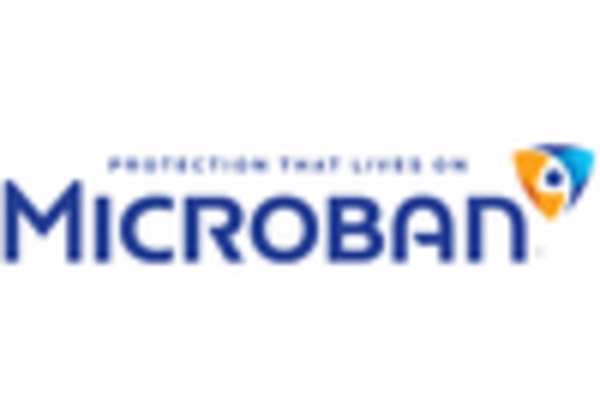Rising Demand for Hygiene Products
The antimicrobial textile-additive market is experiencing a notable surge in demand for hygiene products. This trend is driven by an increasing awareness of health and hygiene among consumers, particularly in textiles used in healthcare, hospitality, and personal care sectors. The market for antimicrobial additives is projected to grow at a CAGR of approximately 8% from 2025 to 2030, reflecting the heightened focus on cleanliness and infection control. As consumers prioritize hygiene, manufacturers are compelled to incorporate antimicrobial properties into their textile products, thereby enhancing their market appeal. This shift not only addresses consumer concerns but also aligns with industry standards for safety and cleanliness, further propelling the antimicrobial textile-additive market forward.
Growth in E-commerce and Online Retail
The antimicrobial textile-additive market is benefiting from the rapid expansion of e-commerce and online retail platforms. As consumers increasingly turn to online shopping for convenience, the demand for antimicrobial textiles, particularly in apparel and home furnishings, is expected to rise. In 2025, online retail sales in the US are projected to reach approximately $1 trillion, with a significant portion attributed to health-conscious consumers seeking antimicrobial options. This trend encourages manufacturers to enhance their online presence and offer a diverse range of antimicrobial textile products. The ease of access to information and product reviews online further influences consumer purchasing decisions, thereby driving growth in the antimicrobial textile-additive market.
Consumer Preference for Performance Fabrics
The antimicrobial textile-additive market is influenced by a growing consumer preference for performance fabrics. These fabrics offer enhanced functionality. As consumers become more active and health-conscious, there is an increasing demand for textiles that provide not only comfort but also antimicrobial properties. This trend is particularly evident in the sportswear and activewear segments, where consumers seek fabrics that can withstand rigorous use while minimizing odor and bacterial growth. The market for performance fabrics is expected to grow significantly, with antimicrobial additives playing a pivotal role in meeting these consumer expectations. This shift in consumer behavior is likely to propel the antimicrobial textile-additive market, as manufacturers respond to the demand for high-performance, functional textiles.
Regulatory Support for Antimicrobial Products
The antimicrobial textile-additive market is likely to benefit from increasing regulatory support. This support aims to promote the use of antimicrobial products in various applications. Regulatory bodies in the US are establishing guidelines that encourage the incorporation of antimicrobial additives in textiles, particularly in sectors such as healthcare and food service. This regulatory environment not only fosters innovation but also instills consumer confidence in the safety and efficacy of antimicrobial textiles. As a result, manufacturers are more inclined to invest in research and development of new antimicrobial additives, which could lead to enhanced product offerings in the market. This supportive regulatory framework is expected to play a crucial role in the growth trajectory of the antimicrobial textile-additive market.
Technological Innovations in Textile Manufacturing
The antimicrobial textile-additive market is witnessing a wave of technological innovations. These innovations are transforming textile manufacturing processes. Advances in nanotechnology and polymer science are enabling the development of more effective and durable antimicrobial additives. These innovations allow for the creation of textiles that not only resist microbial growth but also maintain their properties over extended periods. The market is projected to see a rise in the adoption of smart textiles, which integrate antimicrobial properties with other functionalities, such as moisture management and odor control. This convergence of technology and textile manufacturing is likely to enhance the appeal of antimicrobial products, thereby driving growth in the antimicrobial textile-additive market.

















Leave a Comment